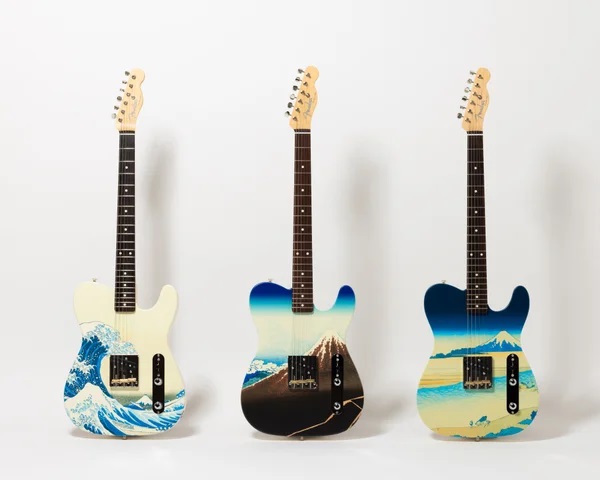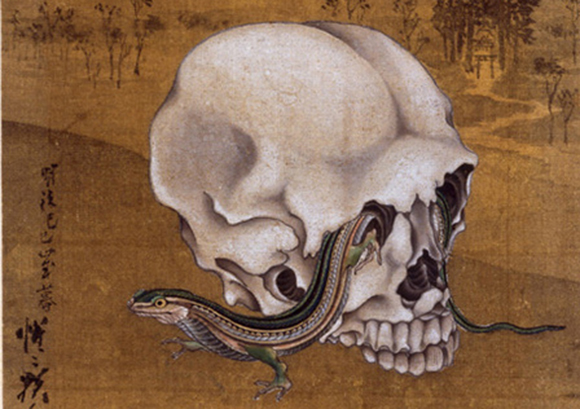Japanese art
This registered tangible cultural asset is now closed to the public, which is an absolute shame.
Sleep amongst lanterns, gods, and traditional motifs at the “very Japanese new sensation capsule hotel”.
“Betobeto-san” © 水木プロダクション (Mizuki Productions)
A parade of monsters is coming to Roppongi Hills this summer, and it sounds like a treat!
Nakagawa Masashichi Shoten, knows that despite being in business for 300 years, you haven’t really made it until you own Boardwalk, Mayfair, or in this case Kyoto’s Nishijin Textile Center.
Meguro Gajoen is one of the tangible properties of Tokyo, established in 1931 originally as a venue for wedding banquets. Now all that remains of the original architecture is a series of rooms connected by the “stairway of 100 steps“. In 2009 these rooms were classified as one of the cultural assets of Japan.
We recently visited the establishment to get a look at the traditional party rooms for ourselves, since they were open to the public for a very short window of time and we figured this would be our only chance. We were even permitted to take photos, so come and join us for a guided tour!
The Tōkaidō is perhaps the most important road in Japan’s history. Built in the 17th century, it connected the country’s two powerhouses: it runs from Kyoto, the imperial capital, to Edo (now Tokyo), the seat of the Shogunate. As well as being an important political and trade route, depictions of the Tōkaidō in art in literature were abundant and popular.
The best-known of these is Utagawa Hiroshiges’s series of ukiyo-e woodcut prints, The Fifty-three Stations of the Tōkaidō. Ukiyo-e woodblock printing like this continued to flourish in Japan until the 19th century.
Less famous than Hiroshige is the relatively unknown ukiyo-e artist Utagawa Yoshishige, who produced his own prints of the 53 stations along the Tōkaido – by depicting each station in the form of a potted landscape.
What do you think of the artwork featured in the new omnibus edition of Lewis Carroll’s Alice’s Adventures in Wonderland and Through the Looking Glass? When Japanese twitter user kasunoko tweeted a pic of the cover image, netizens in Japan were quick to claim that the artwork “doesn’t look very American”. In fact, several of them were of the opinion that the artwork seemed a bit on the, erm, Japanese side. Hmm, we’re not sure what they’re talking about, but check out the images after the jump and let us know your thoughts!
The Asahi Beer Oyamazaki Villa Museum of Art is located in Yamazaki, a place of historical significance in Japan since medieval times when it served as a field of battle for Toyotomi Hideyoshi to avenge the betrayal and murder of his lord Oda Nobuaga. The museum is currently hosting an exhibition that pays homage to the samurai of those ancient times, in a very modern and surreal fashion.
When you think of Japanese ukiyo-e, or woodblock prints, you probably think of Hokusai’s beautiful landscapes in his Thirty Six Views of Mount Fuji, or the stylized prints of beautiful courtesans in traditional Japanese dress. But there are also many pieces of Japanese art and ukiyo-e from the Edo to the Meiji period (between 1603 and 1912) that represent a more mythical and macabre side of Japan.
The following is a collection of 20 pieces that all contain skulls or skeletons in some form, many of them by renowned and famous artists of the time.
With global phenomenon like the Mario and Pokemon franchises under their belts, it’s easy to forget about Nintendo’s humble beginnings as a producer of traditional Japanese playing cards. This year the company goes back to their roots in their 2014 company brochure with beautiful artwork that celebrates both the old and the new.















 We revisited Sweets Paradise after a decade to see if Japan’s dessert buffet still delivers
We revisited Sweets Paradise after a decade to see if Japan’s dessert buffet still delivers Hayao Miyazaki says Happy New Year to Studio Ghibli fans with new art for Year of the Horse
Hayao Miyazaki says Happy New Year to Studio Ghibli fans with new art for Year of the Horse What’s inside the McDonald’s Japan fukubukuro lucky bag for 2026?
What’s inside the McDonald’s Japan fukubukuro lucky bag for 2026? New Studio Ghibli collection includes a US$2,450 wooden Totoro 【Video】
New Studio Ghibli collection includes a US$2,450 wooden Totoro 【Video】 That time Seiji called JASRAC to ask why he didn’t get paid royalties for his song being on TV
That time Seiji called JASRAC to ask why he didn’t get paid royalties for his song being on TV Are all Starbucks coffee sizes the same? Testing the viral video claim in Japan
Are all Starbucks coffee sizes the same? Testing the viral video claim in Japan Studio Ghibli retailer now sells Japanese anime curry with all the special utensils
Studio Ghibli retailer now sells Japanese anime curry with all the special utensils McDonald’s releases new “Yakki” burger based on a popular Japanese meal
McDonald’s releases new “Yakki” burger based on a popular Japanese meal Cup Noodle releases new Tomica “car” collection
Cup Noodle releases new Tomica “car” collection Toilet teaching – Japanese programmer explains key concept with clever bathroom snapshot
Toilet teaching – Japanese programmer explains key concept with clever bathroom snapshot Starbucks Japan ready to get Year of the Horse started with adorable drinkware and plushies【Pics】
Starbucks Japan ready to get Year of the Horse started with adorable drinkware and plushies【Pics】 Cyberpunk anime meets traditional culture in Ghost in the Shell gold leaf Japanese changing screens
Cyberpunk anime meets traditional culture in Ghost in the Shell gold leaf Japanese changing screens 7 great places to see Mt. Fuji from without having to climb it
7 great places to see Mt. Fuji from without having to climb it Hello Kitty Choco Egg figures are an adorable trip through three periods of Japanese pop culture【Pics】
Hello Kitty Choco Egg figures are an adorable trip through three periods of Japanese pop culture【Pics】 7-Eleven Japan’s ramen-cooking robot whipped us up a bowl of noodles【Taste test】
7-Eleven Japan’s ramen-cooking robot whipped us up a bowl of noodles【Taste test】 We found possibly the quietest Japanese-style hotel in Tokyo’s bustling Shinjuku district
We found possibly the quietest Japanese-style hotel in Tokyo’s bustling Shinjuku district Japan’s otoshidama tradition of giving kids money at New Year’s gets a social welfare upgrade
Japan’s otoshidama tradition of giving kids money at New Year’s gets a social welfare upgrade Sumo Sanrio! Hello Kitty and pals team up with Japan Sumo Association for new merch【Pics】
Sumo Sanrio! Hello Kitty and pals team up with Japan Sumo Association for new merch【Pics】 More Than a Capsule Stay: Why Solo Travelers Choose “global cabin Yokohama Chinatown”
More Than a Capsule Stay: Why Solo Travelers Choose “global cabin Yokohama Chinatown” Japan’s oldest largetooth sawfish in captivity back on display in Mie Prefecture
Japan’s oldest largetooth sawfish in captivity back on display in Mie Prefecture 7-Eleven Japan starts new temporary luggage storage service in over 300 branches
7-Eleven Japan starts new temporary luggage storage service in over 300 branches Disillusionment at Tsukiji’s tourist-target prices led us to a great ramen restaurant in Tokyo
Disillusionment at Tsukiji’s tourist-target prices led us to a great ramen restaurant in Tokyo Starbucks teams up with 166-year-old Kyoto doll maker for Year of the Horse decorations【Photos】
Starbucks teams up with 166-year-old Kyoto doll maker for Year of the Horse decorations【Photos】 Tokyo considering law requiring more trash cans following litter increase in heavily touristed area
Tokyo considering law requiring more trash cans following litter increase in heavily touristed area Tokyo’s Tsukiji sushi neighborhood asks tour groups to stay away for the rest of the month
Tokyo’s Tsukiji sushi neighborhood asks tour groups to stay away for the rest of the month Tokyo event lets you travel back in time, for free, to celebrate 100 years since Showa era start
Tokyo event lets you travel back in time, for free, to celebrate 100 years since Showa era start Sanrio theme park in Japan announces plans to expand into a Sanrio resort
Sanrio theme park in Japan announces plans to expand into a Sanrio resort Japan may add Japanese language proficiency, lifestyle classes to permanent foreign resident requirements
Japan may add Japanese language proficiency, lifestyle classes to permanent foreign resident requirements Stamina-destroying “Paralysis Noodles” are Tokyo’s newest over-the-top ramen innovation
Stamina-destroying “Paralysis Noodles” are Tokyo’s newest over-the-top ramen innovation Survey asks foreign tourists what bothered them in Japan, more than half gave same answer
Survey asks foreign tourists what bothered them in Japan, more than half gave same answer Japan’s human washing machines will go on sale to general public, demos to be held in Tokyo
Japan’s human washing machines will go on sale to general public, demos to be held in Tokyo Japan’s deadliest food claims more victims, but why do people keep eating it for New Year’s?
Japan’s deadliest food claims more victims, but why do people keep eating it for New Year’s? We deeply regret going into this tunnel on our walk in the mountains of Japan
We deeply regret going into this tunnel on our walk in the mountains of Japan Studio Ghibli releases Kodama forest spirits from Princess Mononoke to light up your home
Studio Ghibli releases Kodama forest spirits from Princess Mononoke to light up your home Major Japanese hotel chain says reservations via overseas booking sites may not be valid
Major Japanese hotel chain says reservations via overseas booking sites may not be valid Put sesame oil in your coffee? Japanese maker says it’s the best way to start your day【Taste test】
Put sesame oil in your coffee? Japanese maker says it’s the best way to start your day【Taste test】 No more using real katana for tourism activities, Japan’s National Police Agency says
No more using real katana for tourism activities, Japan’s National Police Agency says Starbucks Japan reveals new sakura drinkware collection, inspired by evening cherry blossoms
Starbucks Japan reveals new sakura drinkware collection, inspired by evening cherry blossoms Updated cherry blossom forecast shows extra-long sakura season for Japan this year
Updated cherry blossom forecast shows extra-long sakura season for Japan this year Are all Starbucks coffee sizes the same? Testing the viral video claim in Japan
Are all Starbucks coffee sizes the same? Testing the viral video claim in Japan Studio Ghibli retailer now sells Japanese anime curry with all the special utensils
Studio Ghibli retailer now sells Japanese anime curry with all the special utensils McDonald’s releases new “Yakki” burger based on a popular Japanese meal
McDonald’s releases new “Yakki” burger based on a popular Japanese meal Cup Noodle releases new Tomica “car” collection
Cup Noodle releases new Tomica “car” collection Toilet teaching – Japanese programmer explains key concept with clever bathroom snapshot
Toilet teaching – Japanese programmer explains key concept with clever bathroom snapshot Japanese police are not messing around, with Patlabor robot mecha out on display 【Video】
Japanese police are not messing around, with Patlabor robot mecha out on display 【Video】 The ancient Japanese textile craft made with jagged fingernails
The ancient Japanese textile craft made with jagged fingernails New Japanese bowl-shaped donburi rice cooker cooks rice and toppings at the same time
New Japanese bowl-shaped donburi rice cooker cooks rice and toppings at the same time 7-Eleven Japan’s ramen-cooking robot whipped us up a bowl of noodles【Taste test】
7-Eleven Japan’s ramen-cooking robot whipped us up a bowl of noodles【Taste test】 Take a toothbrush with you to Butakin for this daring mixed noodles with chives dish
Take a toothbrush with you to Butakin for this daring mixed noodles with chives dish Starbucks Japan releases new zodiac chilled cup drink for 2026
Starbucks Japan releases new zodiac chilled cup drink for 2026